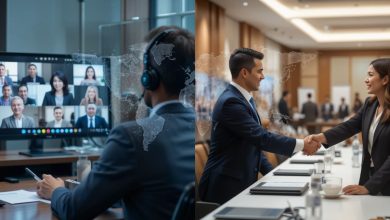Preparing for Remote Interviews: Tools, Etiquette, and Follow-Up Tips
Anúncios
In an era where remote work and virtual communication have become the norm, remote interviews serve as a critical gateway to new career opportunities. Professionals must navigate not only the content of their responses but also the technical and interpersonal dynamics unique to virtual settings. This article provides a structured guide—covering essential tools, etiquette, and follow-up strategies—to help candidates perform confidently and effectively during remote interviews.
Essential Tools for Remote Interviews
Reliable Hardware and Software
Successful remote interviews begin with the right equipment. A high-quality webcam and a clear microphone are foundational. Built-in laptop hardware may suffice, but investing in an external HD webcam and a noise-canceling headset can markedly improve audiovisual clarity. Updated software—such as the latest versions of video conferencing platforms—ensures compatibility and access to new features. Candidates should also confirm that necessary applications are installed and configured well before the scheduled interview time.
Anúncios
Stable Internet Connection
A stable and fast internet connection minimizes lag, freezes, and dropped calls. Professionals should test their upload and download speeds using online speed tests; a minimum of 5 Mbps for both is recommended for seamless video conferencing. Whenever possible, connecting via an Ethernet cable rather than relying solely on Wi-Fi reduces the risk of interruptions. If a wired connection is not feasible, positioning oneself close to the router and limiting bandwidth usage by other devices can help maintain stability.
Backup Solutions
Even the most robust setup can encounter unforeseen issues. Candidates should prepare backup strategies to mitigate risks. This includes having a secondary device—such as a smartphone or tablet—with the video conferencing app installed and configured. Keeping chargers or extra batteries accessible prevents power-related disruptions. Additionally, sharing a brief contingency plan with the interviewer—for example, “If my connection drops, I will quickly call back using my phone”—demonstrates proactive problem-solving and responsibility.
Setting Up the Interview Environment
Choosing the Right Location
Selecting an appropriate location sets the tone for professionalism. A dedicated workspace—such as a quiet home office or a reserved meeting room—minimizes distractions and signals seriousness about the opportunity. Background elements should be tidy and neutral; cluttered or overly personal environments can distract interviewers from focusing on the candidate’s responses. When privacy is limited, noise-cancelling headphones and gentle background music (turned off during the interview) help create a controlled atmosphere.
Anúncios
Lighting and Background Considerations
Optimal lighting ensures that the candidate’s face is clearly visible without harsh shadows or glare. Natural light from a window positioned in front of the interviewer is ideal; if not available, a soft desk lamp placed behind the camera can replicate similar effects. Avoid backlighting—where a strong light source sits behind the candidate—since this silhouette effect obscures facial expressions. For backgrounds, solid or subtly textured walls create a polished appearance. Virtual backgrounds should be avoided unless they function perfectly; glitches can undermine credibility.
Minimizing Distractions
Remote interviews often occur in dynamic household environments. To minimize interruptions, candidates should inform family members or roommates of the scheduled interview time and request their cooperation in maintaining silence. Mobile devices should be set to silent mode or turned off, and any on-screen notifications—emails, messages, or calendar reminders—must be disabled. Clearing desktop clutter ensures that screen sharing, if requested, displays only relevant materials.
Mastering Virtual Interview Etiquette
Professional Appearance
Though remote interviews remove the need for physical commutes, dressing professionally remains essential. Candidates should choose attire that aligns with the company’s culture—typically business casual or formal wear—up to the waist, as only the upper body is visible. Dressing the part reinforces self-confidence and conveys respect for the interviewer’s time. Grooming, posture, and minimal, neat accessories contribute to an overall polished impression.
Body Language and Eye Contact
Body language plays a significant role in virtual settings. Maintaining an upright posture and leaning slightly forward conveys engagement. Using open hand gestures, while keeping movements controlled, adds dynamism without causing distractions. To simulate eye contact, candidates should focus on looking at the camera lens rather than on their own image or the interviewer’s video feed. This small adjustment helps create a sense of direct connection and sincerity.
Communication Clarity
Clear and concise communication reduces misunderstandings in remote interviews, where subtle vocal and visual cues can be lost. Candidates should speak at a measured pace, enunciate words, and pause briefly after each response to allow the interviewer to interject. When interruptions occur due to technical lag, acknowledging the delay—“I apologize, I think I froze momentarily”—maintains professionalism and transparency. Active listening cues—nodding, smiling, and using brief affirmations—signal attentiveness and foster rapport.
Technical and Behavioral Preparation
Testing Technology in Advance
A successful remote interview depends on pre-interview technical checks. Candidates should schedule a mock call with a friend or family member using the same video conferencing platform. This trial run helps identify potential audio, video, or connectivity issues. Testing features such as screen sharing, virtual backgrounds (if necessary), and microphone sensitivity ensures familiarity with the platform’s interface. Arranging these checks at least one day prior provides buffer time to address unexpected complications.
Researching the Company and Role
Strong preparation extends beyond logistical readiness. Understanding the company’s mission, values, and recent developments allows candidates to tailor responses and demonstrate genuine interest. Reviewing the job description in detail helps align key experiences with required competencies. During the remote interview, individuals can reference specific projects or initiatives to showcase research effort and contextual knowledge. This level of preparation conveys enthusiasm and reinforces cultural fit.
Practicing Common Interview Questions
Behavioral and technical questions often remain consistent across formats. Candidates should prepare concise, structured responses using frameworks like STAR (Situation, Task, Action, Result) to highlight achievements. Practicing answers aloud—or even recording oneself—illuminates areas for improvement in delivery, tone, and pacing. Mock interviews, whether virtual or in-person, offer feedback opportunities to refine body language, reduce filler words, and enhance overall confidence. This rigorous practice ensures that responses remain coherent and relevant under the pressure of the actual interview.
Effective Follow-Up Tips
Prompt and Personalized Thank-You Notes
Immediately following the remote interview—ideally within 24 hours—candidates should send a thank-you message to each interviewer. These notes should be personalized, referencing specific aspects of the conversation, such as a shared perspective on a project or the most engaging question posed. Concise gratitude reinforces professionalism and keeps the candidate top of mind. Briefly restating enthusiasm for the role and summarizing how one’s skills align with organizational goals ensures that the follow-up is both courteous and substantive.
Reflecting on Interview Performance
After sending thank-you notes, candidates should conduct a self-assessment to identify strengths and areas for improvement. Reflecting on questions that were challenging, noting technical hiccups, and evaluating the effectiveness of communication strategies aid continuous learning. Documenting this feedback—through written notes or voice memos—helps guide preparation for subsequent interviews. Engaging in this reflective practice fosters resilience and facilitates incremental progress toward mastering remote interview dynamics.
Maintaining Professional Connections
Regardless of the immediate outcome, nurturing relationships with interviewers and recruiters benefits long-term career growth. Candidates can connect on professional networking platforms, sharing relevant industry insights or congratulating interviewers on their company’s milestones. Periodic check-ins—such as sending an article related to a topic discussed or offering an update on skill development—demonstrate ongoing interest without being intrusive. Cultivating these connections builds a network of industry contacts who may offer future opportunities, referrals, or valuable mentorship.
Future Outlook for Remote Interviewing
Increasing Use of Simulation and AI Tools
As remote interviews evolve, companies are incorporating advanced technologies—such as virtual reality simulations or AI-driven behavioral assessments—to evaluate candidates. Candidates may encounter technical screens simulating job-related tasks or prerecorded questions analyzed by algorithms for facial expressions and speech patterns. Preparing for these developments requires familiarity with emerging platforms, practicing on diverse interfaces, and maintaining agility in adapting to novel evaluation methods.
Emphasis on Soft Skills in Virtual Contexts
The proliferation of remote work heightens the importance of soft skills—communication, adaptability, and emotional intelligence—in virtual interviews. Employers seek candidates who can collaborate effectively across digital channels, manage time zones sensitively, and demonstrate cultural agility. Highlighting these qualities during remote interviews—through examples of past remote project success or strategies for virtual teamwork—aligns candidate profiles with evolving employer expectations.
Hybrid Interview Models
Many organizations are adopting hybrid recruitment processes, combining remote initial screenings with in-person final rounds. Candidates should be prepared to transition smoothly between digital and physical environments. This means reinforcing lessons learned in remote interview preparation while also demonstrating readiness for on-site assessments—such as facility tours, in-person role plays, or face-to-face final interviews. Balancing virtual proficiency with traditional interpersonal skills ensures a comprehensive approach to modern recruitment.
Conclusion
Preparing for remote interviews demands comprehensive planning across technical, environmental, and interpersonal dimensions. By equipping oneself with reliable tools, optimizing the interview setting, mastering virtual etiquette, and executing thoughtful follow-up, candidates position themselves for success in an increasingly digital hiring landscape. As remote interviewing continues to evolve—with greater reliance on AI-driven assessment and nuanced evaluation of soft skills—professionals who invest in continuous learning and adaptability will thrive. Ultimately, a methodical approach to preparation, combined with self-awareness and strategic follow-up, empowers candidates to make lasting impressions and secure desired roles in virtual and hybrid work environments.
Published on: 6 de June de 2025








